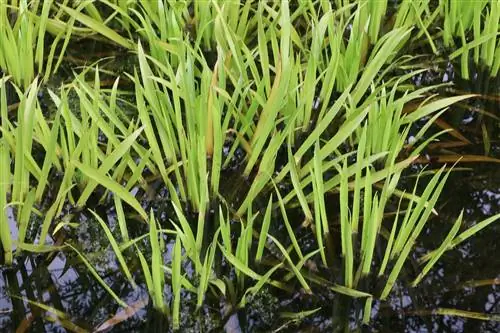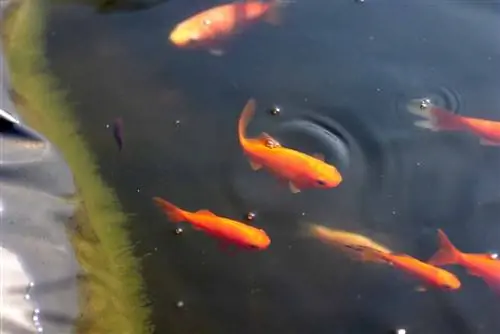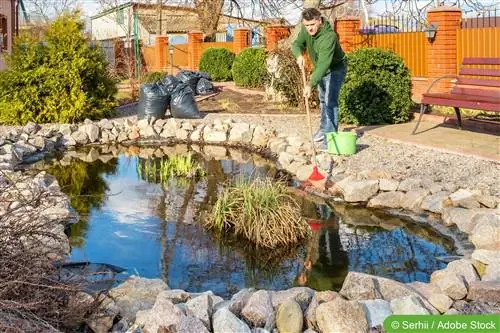- Author admin [email protected].
- Public 2023-12-17 03:39.
- Last modified 2025-01-24 12:45.
The crab claw, also known as water aloe, is a hardy aquatic plant that is very often found in home garden ponds. Although it is rarely seen in most cases, it fulfills an important mission. Crab claws are protected and may not be taken from the wild.
Cancer scissors: hardy evergreen aquatic plant
Crayfish claws, whose botanical name is Stratiotes aloides, are floating aquatic plants. The rosette-shaped plants are not always visible on the surface of the water, but when they stretch their fronds into the air during flowering, they are very decorative. The flowers they then develop are white and rather inconspicuous. Even though the plants spend most of their time underwater, they are highly valued by pond owners. They remove excess nutrients from the water and thus prevent excessive algae infestation.
The foothills below the water surface supply the water with additional oxygen, which is particularly beneficial when stocked with fish or other aquatic animals. The sharp leaves offer animal inhabitants good hiding places both above and under water. Above water they are often used by water striders and are used as breeding grounds by dragonflies and other water-loving insects.
- Crab claws are hardy
- they improve water quality
- they promote the settlement of insects
- they are protected
Depending on the size of the pond, three or more crab claws are used for maintenance in the garden pond. Fewer plants make maintenance easier than if too many grow in the pond. Other pond owners are often happy to give away unnecessary crab claws. Specialist retailers also have a wide range available. The pond owner should not be put off by the sometimes somewhat pitiful appearance. With good water quality and a sufficient supply of food, even unsightly specimens quickly grow to an impressive size. After a while it often becomes necessary to trim or remove the plants so that they don't put too much pressure on other pond plants.
Crab claws need clean, soft water in a sunny location
Crab claws are not planted in the pond bottom. The plants are simply placed in the pond. They find their own place very quickly. To do this, they develop runners up to two meters long and a strong network of roots with which they anchor themselves in the bottom of the pond. They don't like being tied up and fixed in a certain place. Then they take care of or die after a short time. The pond owner should not be alarmed if the plant is initially only found low to the ground. If the water quality is good, it will appear on its own as soon as it has flowers.
Some crab claws need several months before they venture to the surface of the water. Very small plants sometimes take several years until they develop their first flowers. The demands on the location are quite low. Nutrient-rich water that is as soft as possible helps plants thrive. In calcareous water, the crayfish grows very poorly or even dies. A sunny or partially shaded location promotes growth. The long runners then form on which new rosettes appear. Even though crab claws need water that is very rich in nutrients, they cannot tolerate contaminated water. If the plants are not thriving, purifying the pond water may be helpful.
- clean, nutrient-rich water
- sunny or semi-sunny location
- lightening regularly
Caring for crab claws
The main care takes place in autumn. It is then necessary to remove part of the crab claws from the pond with a rake or landing net. Be careful when touching it. The leaves have very sharp edges and can cause cuts. If the plants spread too much in summer, thinning should begin earlier. When the water temperature falls below 15 degrees Celsius, the plants sink to the bottom. A large part of the old rosettes dies and dissolves in the water. The surviving rosettes form winter buds and overwinter at the bottom of the pond. They only reappear when the water temperatures rise and reach the surface of the water during flowering.
Propagate crab claws
If the water quality is good, the pond owner does not need to worry about the propagation of the plant; on the contrary, he will be more concerned with containing the spread. Crab claws are usually propagated by separating the new rosettes. But the runners are also suitable for growing new plants. To do this, a piece of the shoot that has already formed roots is selected and cut off. The shoot then only needs to be placed in the water. Propagation by seeds is also possible if the plant has flowered and the seeds have been collected. However, this type of breeding is much more complicated, so generally only the shoots or small rosettes are used.
Problems with care
Crayfish claws are considered useful aquatic plants that are very easy to care for. The plant has no pests. It offers protection to the pond inhabitants and helps to improve water quality. The only problem is the widespread spread of crab claws, which can overgrow entire pond surfaces under favorable conditions. Regular inspection and, if necessary, thinning prevents this problem.
What you should know about crab claws in brief
The crab claw is an easy-to-care for floating plant that is particularly suitable for keeping in the pond from an ecological point of view. If cared for properly, it improves water quality and promotes the settlement of important insects.
- As an aquatic plant, the crab claw gets its name from the scissor-like coverings of the inflorescences.
- The plants form swimming communities.
- They prefer warm, wind-protected, sunny, muddy, alkaline-rich, not polluted and mostly stagnant waters,
- for example in valley floodplains, in backwaters, ditches, ponds and canals.
- Crab claws are propagated via seeds or vegetatively via runners.
- The plant is sensitive to strong fluctuations in water levels and to contamination.
- Because of their appearance, the crab claws fit very well into a Mediterranean garden.
- Due to its ability to bind phosphorus and potassium, the crab claw is an ideal pond plant.
The funnel-shaped growth habit is similar to an aloe. The leaves of the crab claw are up to 40 cm large, long sword-shaped fronds arranged in rosettes. They are triangular and jaggedly sawn forward and partially protrude out of the water. Intensive runners form, which connects the individual rosettes to form large units. The plant's unbranched aquatic roots are dense and hang beneath the plant. They absorb nutrients from the water. The flowers are quite small. They each consist of three white corollas and three green sepals. The flower center is yellow. The plant blooms from May to July.
- The gregarious crab claws only float on the surface of the water during the summer months.
- In autumn, the rosettes sink to the bottom of the water and form winter buds (turions).
- The outer leaves die off. In spring the turions rise to the surface of the water again and form new plants.
- In contrast to other aquatic plants, the heart of old rosettes rises again and continues to grow.
- Daughter plants grow very quickly over the large mother plants and develop vigorously over the summer.
- The rosettes that grow like tiers on top of each other form an impenetrable jungle, especially in flat areas.
- The strong biomass production of large deposits promotes siltation (silt forming) in water bodies. The species is spread by flooding.
The crab claw is on the red list and is considered particularly protected. It is almost extinct in natural waters. It was fought intensively by anglers in fish ponds because of its rampant growth.






